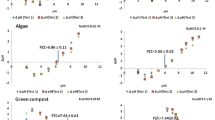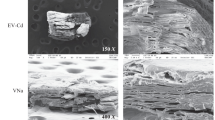Abstract
Diquat2+ (1, 1’-ethylene-2, 2’-dipyridinium ion) and paraquat2+ (1, 1’-dimethyl-4, 4’-di-pyridinium ion) were competitively adsorbed by Na-saturated kaolinites, smectites and expanded and collapsed vermiculites. The relative preference for one or the other cation varied with the surface charge densities of the adsorbents and the location of the adsorption site, i.e. internal or external. Minerals with high surface charge exhibited preference for diquat whereas minerals with low surface charge preferred paraquat. Expanded vermiculites preferentially adsorbed diquat on internal surfaces. Collapsed vermiculites generally showed a preference for paraquat. Smectites and kaolinites preferentially adsorbed paraquat.
Surface charge densities of the layer silicates vs. the relative preference for diquat revealed two linear relationships, one for internal adsorption and one for external adsorption. Internal adsorption was characterized by a strong preference for paraquat on low-charged smectites, a relative decreasing preference for paraquat with higher-charged smectites, and a strong preference for diquat on high-charged expanded vermiculites.
Preferential adsorption for paraquat by kaolinite was quite similar to adsorption of paraquat on the external sites of vermiculites. There was no apparent relationship between competitive adsorption and surface charge density of kaolinite.
Résumé
Le diquat2+ (ion 1,1′-éthylène-2,2′-dipyridinium) et le paraquat2+ (ion 1,1′-diméthyl-4,4′-dipyridinium) ont été adsorbés d'une manière compétitive par des kaolinites Na, des smectites et des vermiculites gonflées et fermées. La sélectivité relative pour l'un ou l'autre des deux cations varie avec les densités de charge superficielle des adsorbants et la localisation interne ou externe du site d'adsorption. Les minéraux à forte charge de surface montrent une sélectivité pour le diquat alors que les minéraux à faible charge de surface retiennent préférentiellement le paraquat. Les vermiculites gonflées adsorbent préférentiellement le diquat sur les surfaces internes. Les vermiculites fermées montrent en général une préférence pour le paraquat. Les smectites et les kaolinites adsorbent préférentiellement le paraquat.
La corrélation entre les densités de charge superficielle des phyllosilicates et la préférence relative pour le diquat révèle deux relations linéaires, une pour l'adsorption interne et une pour l'adsorption externe. L'adsorption interne a été caractérisée par une forte préférence pour le paraquat sur les smectites à faible charge, une préférence relative pour le paraquat qui diminue quand la charge des smectites augmente, et une forte préférence pour le diquat sur les vermiculites gonflées à forte charge.
L'adsorption préférentielle du paraquat sur la kaolinite est tout à fait semblable à l'adsorption du paraquat sur les sites externes des vermiculites. Il n'y a pas de relation apparente entre l'adsorption compétitive et la densité de charge superficielle de la kaolinite.
Kurzreferat
Diquat2+(1,1′-äthylan-2,2′-dipyridinium ion) und Paraquat2+(1,1′-dimethyl-4,4′-dipyridinium ion) wurden im Wettbewerb miteinander an Na-gesättigten Kaoliniten, Smectiten und aufgeblähten sowie zusammengeschrumpften Vermiculiten adsorbiert. Die relative Vorliebe für das eine oder das andere Kation änderte sich im Zusammenhang mit den Oberflächenladungschten der Adsorbenten und der Lage der Adsorptionsstelle, d.h. innerlich oder äusserlich. Minerale mit hoher Oberflächenladungs zeigten Vorzug für Diquat während Minerale mit niedriger Oberflächenladung Paraquat vorzogen. Aufgeblähte Vermiculite adsorbierten vorzugsweise Diquat an den inneren Oberflächen, während die zusammengeschrumpften Vermiculite im allgemeinen dem Paraquat den Vorzug gaben. Smectite und Kaolinite adsorbierten mit Vorliebe Paraquat.
Eine Betrachtung der Oberflächenladungsdichten der Schichtsilikate in bezug auf die relative Vorliebe für Diquat zeigte zwei Linearbeziehungen, eine für interne Adsorption und eine für externe Adsorption. Interne Adsorption war gekennzsichnet durch eine starke Vorliebe für Paraquat auf niedriggeladenen Smectiten, eine relativ abnehmende Vorliebe für Paraquat bei höher geladenen Smectiten und eine deutliche Vorliebe für Diquat an hochgeladenen aufgeblähten Vermiculiten.
Vorzugsweise Adsorption für Paraquat durch Kaolinit war ganz ähnlich der Adsorption von Paraquat an den externen Stellen von Vermiculiten. Es ergab sich keine sichtbare Beziehung zwischen konkurrierender Adsorption und Oberflächenladungsdichte von Kaolinit.
Резюме
Сопоставлена адсорбция ионов дикуат2+(1,Г-этилен-2,2’-дипиридин) и паракуат2 + (1,Г-диметил-4,4’-дилиридин) насыщенными натрием каолинитом, смектитом, а также вермикулитом в состоянии набухания и после удаления растворителя. Установлено, что преимущественная адсорбция одного или другого катиона варьирует в зависимости от плотности заряда на поверхности адсорбентов и внутреннего или наружного положения адсорбционных позиций. Минералы с высоким поверхностным зарядом преимущественно адсорбировали дикуат, а минералы с низким поверхностным зарядом — паракуат. Набухший вермикулит наиболее энергично адсорбировал дикуат на внутренней поверхности. После удаления растворителя вермикулит в общем более интенсивно поглощал паракуат. Смектиты и каолиниты избирательно извлекали из раствора паракуат.
Зависимость от плотности поверхностных зарядов слоистых силикатов преимущественной адсорбции дикуата выражается двумя линейными соотношениями: одно для внутренней адсорбции, другое — для внешней. Внутренняя адсорбция характеризуется сильным преобладанием поглощения паракуата у слабо заряженных смектитов: у сильно заряженных смектитов адсорбция паракуата относительно снижается; сильно заряженные набухшие вермикулиты обнаруживают сильное избирательное поглощение по отношению к дикуату. Преимущественная адсорбция паракуата каолинитом аналогична адсорбции паракуата на внешних позициях вермикулитов. У каолинитов не удалось установить определенного соотношения между избирательной адсорбцией и плотностью зарядов на поверхности.
Similar content being viewed by others
References
Carter, D. L., Heilman M. D. and Gonzalez, C. L. (1965) Ethylene glycol monoethyl ether for determining surface area of silicate minerals: Soil Sci. 100, 356–360.
Harward, M. E. and Brindley, G. W. (1966) Swelling properties of synthetic smectites in relation to lattice substitutions: Clays and Clay Minerals 13, 209–222.
Harward, M. E., Carstea, D. D. and Sayegh, A. H. (1969) Properties of vermiculites and smectites: expansion and collapse: Clays and Clay Minerals 16, 437–447.
Jackson, M. L. (1956) Soil Chemical Analysis-Advanced course. Published by the author, Soils Department, University of Wisconsin, Madison.
Okazaki, R., Smith, H. W. and Moodie, C. D. (1962) Development of a cation-exchange capacity procedure with few inherent errors: Soil Sci. 93, 343–349.
Philen, O. D., Jr., Weed, S. B. and Weber, J. B. (1970) Estimation of surface charge density of mica and ver-miculite by competitive adsorption of diquat2+ versus paraquat: SoilSci. Soc.Am. Proc. 34, 527–531.
Rich, C. I. (1961) Calcium determination for cation-exchange capacity measurement: Soil Sci. 92, 226–231.
Rich, C. I. (1962) Removal of excess salt in cation-exchange capacity determinations: Soil Sci. 93, 87–94.
Schultz, L. G. (1969) Lithium and potassium adsorption, dehydroxylation temperature, and structural water content of aluminous smectites: Clays and Clay Minerals 17, 115–149.
Shapiro, L. and Brannock, W. W. (1956) Rapid Analysis of Silicate Rocks. Geol. Surv. Bull. 1036-C.
Weed, S. B. and Weber, J. B. (1968) The effect of adsorbent charge on the competitive adsorption of divalent organic cations by layer-silicate minerals: Am. Mineralogist 53, 478–490.
Weed, S. B. and Weber, J. B. (1969) The effect of cation-exchange capacity on the retention of diquat2+ and paraquat” by three-layer type clay minerals —I. Adsorption and release: Soil Sci. Soc. Am. Proc. 33, 379–382.
Author information
Authors and Affiliations
Additional information
Paper No. 3392 of the Journal Series of the North Carolina State University Agr. Exp. Sta., Raleigh, N. C. 27607.
Rights and permissions
About this article
Cite this article
Philen, O.D., Weed, S.B. & Weber, J.B. Surface Charge Characterization of Layer Silicates by Competitive Adsorption of Two Organic Divalent Cations. Clays Clay Miner. 19, 295–302 (1971). https://doi.org/10.1346/CCMN.1971.0190505
Received:
Published:
Issue Date:
DOI: https://doi.org/10.1346/CCMN.1971.0190505




